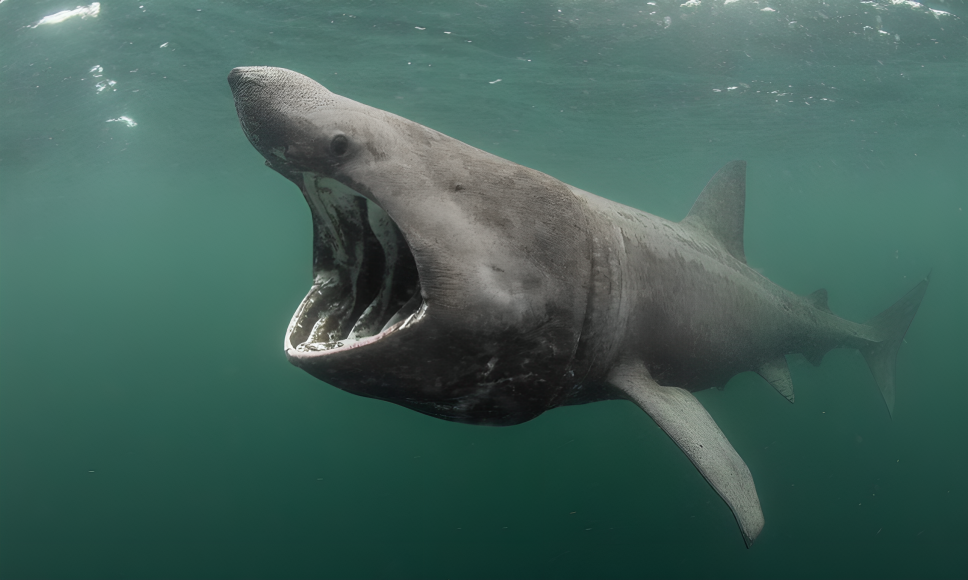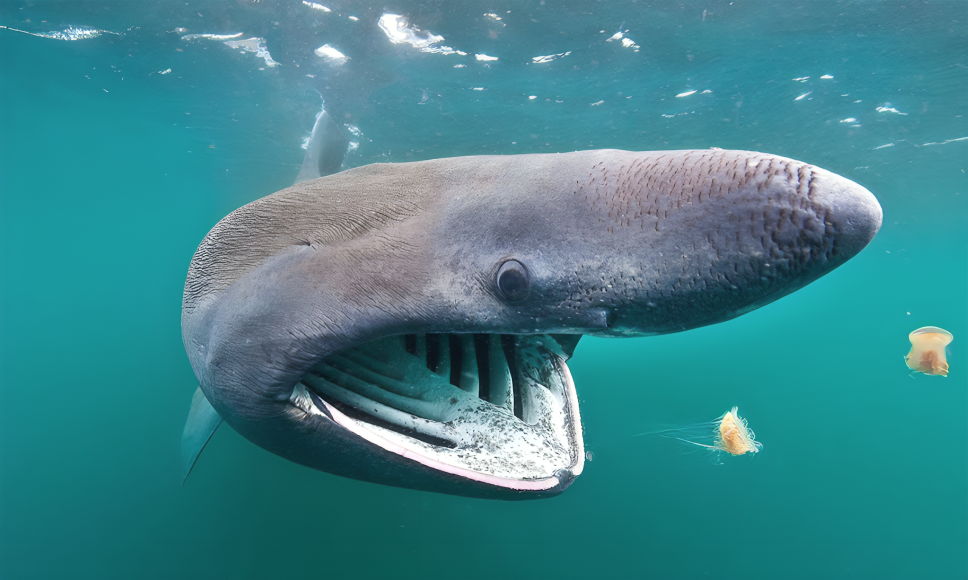Introduction
Basking sharks, the second-largest fish in the world, are a fascinating and often misunderstood marine species. Despite their massive size—reaching up to 40 feet in length—they are gentle giants, gliding through the oceans with mouths agape, filtering plankton from the water. Recently, these mysterious creatures have been making headlines, capturing the attention of marine biologists, environmentalists, and ocean enthusiasts alike. In this blog post, we’ll dive into the latest basking shark news, exploring their behavior, conservation efforts, and why they are becoming a focal point in marine science.
Basking Shark Sightings on the Rise

One of the most exciting developments in recent basking shark news is the increase in sightings around various coastal regions. Particularly, the waters around the UK and Ireland have become hotspots for these magnificent creatures. During the spring and summer months, basking sharks migrate to these cooler waters, following the plankton blooms that make up their primary food source.
Why the Increase?
There are several factors contributing to the rise in basking shark sightings. Climate change plays a significant role, as warming ocean temperatures alter the distribution of plankton, drawing sharks closer to shore. Additionally, conservation efforts and better protection of marine habitats have led to healthier ecosystems, supporting larger populations of plankton and, consequently, basking sharks.
The Importance of Public Sightings
Public reports of basking shark sightings are crucial for marine researchers. These reports help scientists track the movements and behaviors of these sharks, contributing valuable data to ongoing studies. Organizations such as the Basking Shark Project and the Irish Basking Shark Group encourage the public to report sightings, which can be as simple as submitting a location and a photograph.
Conservation Efforts: Protecting the Basking Shark
Basking sharks are currently listed as “Vulnerable” on the IUCN Red List, meaning they face a high risk of extinction in the wild. This status has prompted a wave of conservation efforts aimed at protecting these gentle giants and their habitats.
Marine Protected Areas (MPAs)
One of the most effective strategies for basking shark conservation is the establishment of Marine Protected Areas (MPAs). These areas restrict human activities such as fishing, boating, and drilling, which can disturb or harm marine life. Recent basking shark news highlights the expansion of MPAs in regions where these sharks are frequently spotted, particularly around the British Isles and the west coast of Ireland.
Legislation and International Cooperation
In addition to MPAs, legislation is crucial in protecting basking sharks. Several countries have implemented laws prohibiting the hunting and trading of basking sharks and their parts, particularly their fins, which are highly prized in some cultures. International cooperation is also essential, as these sharks are highly migratory, often crossing multiple national boundaries. Recent discussions at the United Nations have focused on creating more comprehensive international protections for migratory species like the basking shark.
Basking Shark Behavior: What Have We Learned?
Despite being one of the largest fish in the ocean, much about basking sharks remains a mystery. However, recent studies have shed light on some of their behaviors, offering new insights into their lives.
Feeding Habits
Basking sharks are filter feeders, consuming vast amounts of plankton by swimming with their mouths wide open. This feeding method is incredibly efficient, allowing them to process thousands of liters of water per hour. Interestingly, recent basking shark news has revealed that these sharks may also feed at greater depths than previously thought. Using satellite tags, researchers have tracked basking sharks diving to depths of over 1,000 meters in search of food, suggesting that their diet and feeding strategies may be more complex than originally believed.
Migration Patterns
Basking sharks are known for their long migrations, often traveling thousands of kilometers between feeding and breeding grounds. However, the exact routes and destinations of these migrations are still not fully understood. Recent advances in satellite tracking technology have provided new data, revealing that some basking sharks travel across entire ocean basins, crossing the Atlantic from the UK to the Americas. This new information is vital for conservation efforts, as it highlights the need for international cooperation in protecting these migratory routes.
Social Behavior
Another area of interest in basking shark behavior is their social interactions. While they are often seen alone, basking sharks are known to form large groups, particularly during feeding times. Recent basking shark news suggests that these gatherings may also play a role in their mating behaviors, though much remains to be discovered. Some researchers believe that these aggregations could be an opportunity for basking sharks to find mates, though direct observations of mating have yet to be documented.
The Role of Citizen Science in Basking Shark Research
Citizen science has become an invaluable tool in the study of basking sharks. With the rise of digital technology, anyone with a smartphone can contribute to scientific research by reporting basking shark sightings. This approach has democratized marine research, allowing everyday people to play a role in the conservation of these incredible animals.
How to Get Involved
If you’re interested in contributing to basking shark research, there are several ways to get involved. Many organizations run citizen science programs where you can report sightings, submit photographs, and even help with data collection. For instance, the Shark Trust’s “Basking Shark Project” offers guidelines on how to safely observe and report basking shark sightings. By participating, you can help researchers track these animals’ movements, behaviors, and populations.
Success Stories
Recent basking shark news is full of success stories from citizen science initiatives. In 2023, a massive aggregation of over 50 basking sharks was spotted off the coast of Cornwall, UK, largely thanks to reports from local boaters and tourists. This sighting provided researchers with crucial data, helping to confirm theories about the sharks’ seasonal migration patterns and social behaviors.
Challenges Facing Basking Sharks
While there is much to celebrate in the recent basking shark news, these creatures still face significant challenges. Overfishing, climate change, and habitat destruction all threaten their survival. Understanding these threats is key to developing effective conservation strategies.
Overfishing and Bycatch
Although basking sharks are protected in many parts of the world, they are still at risk from bycatch—being unintentionally caught in fishing gear meant for other species. This is a major problem in areas where large-scale commercial fishing operations are common. Efforts to reduce bycatch include developing more selective fishing gear and implementing stricter regulations in areas where basking sharks are known to frequent.
Climate Change
Climate change is perhaps the most significant long-term threat to basking sharks. As ocean temperatures rise, the distribution of plankton—their primary food source—changes. This can force basking sharks to alter their migration routes, potentially putting them at risk if they move into areas where they are not protected. Additionally, warming oceans can lead to more frequent and intense storms, which can disrupt basking shark habitats and migration patterns.
Pollution and Habitat Destruction
Pollution, particularly plastic pollution, is another significant threat to basking sharks. These animals can inadvertently ingest plastic debris while feeding, which can cause injury or death. Furthermore, coastal development and human activities such as shipping and tourism can damage critical habitats, particularly in areas where basking sharks come to feed or breed. Protecting these habitats is essential for the long-term survival of the species.
The Future of Basking Shark Conservation
Looking ahead, the future of basking shark conservation will likely depend on a combination of scientific research, public awareness, and international cooperation. The more we learn about these incredible animals, the better equipped we will be to protect them.
Innovative Research Techniques
Advances in technology are opening up new possibilities for studying basking sharks. For example, drones are increasingly being used to monitor shark populations from the air, providing a non-invasive way to observe their behaviors and movements. Additionally, genetic research is helping scientists understand the population structure of basking sharks, which can inform conservation strategies.
Public Engagement
Public engagement will also play a crucial role in the future of basking shark conservation. The more people know about these gentle giants, the more likely they are to support conservation efforts. Educational programs, documentaries, and social media campaigns are all effective ways to raise awareness and inspire action.
International Cooperation
Finally, international cooperation will be essential for protecting basking sharks, particularly given their migratory nature. This will require countries to work together to create and enforce laws that protect these animals across their entire range. Recent basking shark news highlights the importance of ongoing discussions at international forums, such as the Convention on Migratory Species, which aims to improve protections for migratory species like the basking shark.
Conclusion
Basking sharks are truly one of the ocean’s most fascinating creatures. The recent surge in basking shark news reflects a growing awareness of the importance of these animals and the need to protect them. By continuing to study their behaviors, protect their habitats, and engage the public in conservation efforts, we can ensure that future generations will be able to marvel at these gentle giants of the sea. Whether through citizen science, supporting conservation organizations, or simply spreading the word, we all have a role to play in the ongoing story of the basking shark.



